Shuping Dang
Analysis on Energy Efficiency of RIS-Assisted Multiuser Downlink Near-Field Communications
May 23, 2025Abstract:In this paper, we focus on the energy efficiency (EE) optimization and analysis of reconfigurable intelligent surface (RIS)-assisted multiuser downlink near-field communications. Specifically, we conduct a comprehensive study on several key factors affecting EE performance, including the number of RIS elements, the types of reconfigurable elements, reconfiguration resolutions, and the maximum transmit power. To accurately capture the power characteristics of RISs, we adopt more practical power consumption models for three commonly used reconfigurable elements in RISs: PIN diodes, varactor diodes, and radio frequency (RF) switches. These different elements may result in RIS systems exhibiting significantly different energy efficiencies (EEs), even when their spectral efficiencies (SEs) are similar. Considering discrete phases implemented at most RISs in practice, which makes their optimization NP-hard, we develop a nested alternating optimization framework to maximize EE, consisting of an outer integer-based optimization for discrete RIS phase reconfigurations and a nested non-convex optimization for continuous transmit power allocation within each iteration. Extensive comparisons with multiple benchmark schemes validate the effectiveness and efficiency of the proposed framework. Furthermore, based on the proposed optimization method, we analyze the EE performance of RISs across different key factors and identify the optimal RIS architecture yielding the highest EE.
Unleashing the Potential of Beamspace Modulation in Near-Field MIMO: Opportunities and Challenges
Sep 29, 2024



Abstract:The principal distinction in transitioning from far-field multiple-input multiple-output (MIMO) systems to near-field MIMO configurations lies in the notable augmentation of spatial degrees of freedom (DoF). This increase is not static;rather, it dynamically fluctuates in response to user mobility. A critical challenge emerges in effectively leveraging this significantly enhanced and continuously evolving spatial DoF, particularly when constrained by a limited and energy-intensive array of radio frequency (RF) chains. This article presents an exhaustive review of the current methodologies for exploring spatial DoF in MIMO systems, with a particular emphasis on the near-field context. Central to this review is the exploration of beamspace modulation, a technique that ingeniously capitalizes on the increased and dynamic spatial DoFs inherent in near-field MIMO systems. This strategic exploitation is demonstrated to yield significant enhancements in both spectral efficiency and system reliability. Furthermore, the article delves into a detailed analysis of the multifaceted challenges associated with implementing this technology. Through this comprehensive evaluation, the work provides crucial insights into ongoing efforts to navigate these challenges and suggests potential pathways for future research in this rapidly evolving field.
Blockage-Aware Robust Beamforming in RIS-Aided Mobile Millimeter Wave MIMO Systems
Mar 02, 2024



Abstract:Millimeter wave (mmWave) communications are sensitive to blockage over radio propagation paths. The emerging paradigm of reconfigurable intelligent surface (RIS) has the potential to overcome this issue by its ability to arbitrarily reflect the incident signals toward desired directions. This paper proposes a Neyman-Pearson (NP) criterion-based blockage-aware algorithm to improve communication resilience against blockage in mobile mmWave multiple input multiple output (MIMO) systems. By virtue of this pragmatic blockage-aware technique, we further propose an outage-constrained beamforming design for downlink mmWave MIMO transmission to achieve outage probability minimization and achievable rate maximization. To minimize the outage probability, a robust RIS beamformer with variant beamwidth is designed to combat uncertain channel state information (CSI). For the rate maximization problem, an accelerated projected gradient descent (PGD) algorithm is developed to solve the computational challenge of high-dimensional RIS phase-shift matrix (PSM) optimization. Particularly, we leverage a subspace constraint to reduce the scope of the projection operation and formulate a new Nesterov momentum acceleration scheme to speed up the convergence process of PGD. Extensive experiments confirm the effectiveness of the proposed blockage-aware approach, and the proposed accelerated PGD algorithm outperforms a number of representative baseline algorithms in terms of the achievable rate.
Low-Complexity Resource Management for MC-RSMA in URLLC With Imperfect CSIT
Dec 29, 2023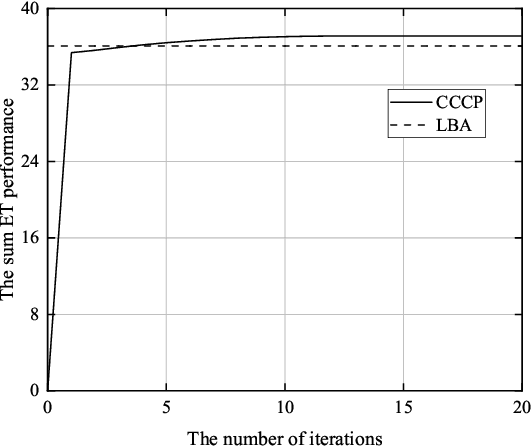
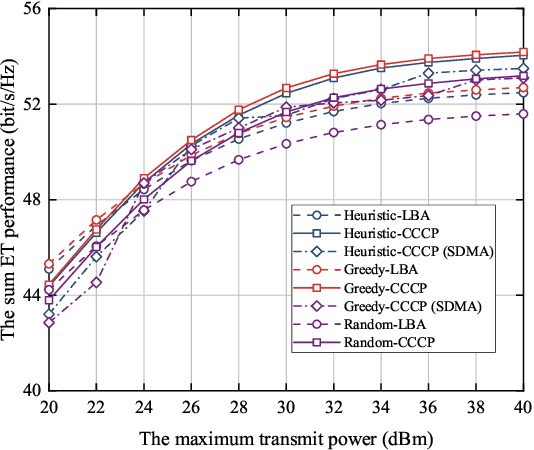
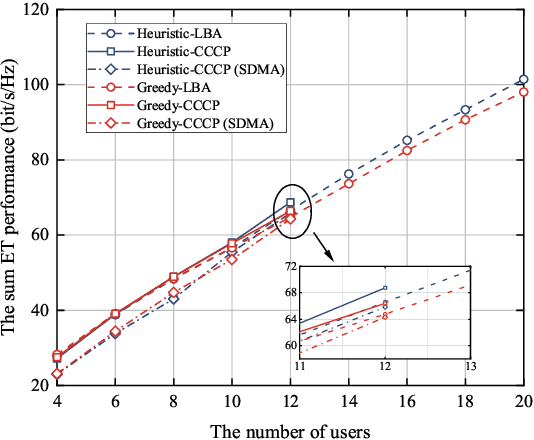
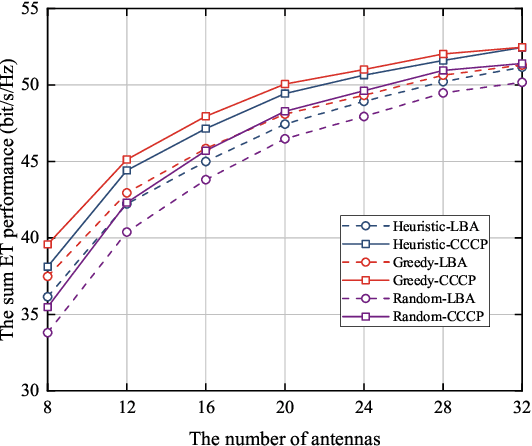
Abstract:This paper investigates low-complexity resource management design in multi-carrier rate-splitting multiple access (MC-RSMA) systems with imperfect channel state information (CSI) for ultra-reliable and low-latency communications (URLLC) applications. To explore the trade-off between the decoding error probability and achievable rate, effective throughput (ET) is adopted as the utility function in this study. Then, a mixed-integer non-convex problem is formulated, where power allocation, rate adaption, and user grouping are jointly taken into consideration. To solve this problem, we first prove that ET is a monotone increasing function of rate under the strict reliability constraint of URLLC. Based on this proposition, an iteration-based concave-convex programming (CCCP) method and an iteration-free lower-bound approximation (LBA) method are developed to optimize power allocation within a single subcarrier. Next, a dynamic programming (DP)-based method is proposed to determine near-optimal user grouping schemes. Besides, a CSI-based method is further proposed to reduce the complexity and obtain important insights into user grouping for MC-RSMA systems. The simulation results verify the effectiveness of the CCCP and LBA methods in power allocation and the DP-based and CSI-based methods in user grouping. Besides, the superiority of RSMA for URLLC services is demonstrated when compared to spatial division multiple access.
Green Holographic MIMO Communications With A Few Transmit Radio Frequency Chains
Sep 22, 2023



Abstract:Holographic multiple-input multiple-output (MIMO) communications are widely recognized as a promising candidate for the next-generation air interface. With holographic MIMO surface, the number of the spatial degrees-of-freedom (DoFs) considerably increases and also significantly varies as the user moves. To fully employ the large and varying number of spatial DoFs, the number of equipped RF chains has to be larger than or equal to the largest number of spatial DoFs. However, this causes much waste as radio frequency (RF) chains (especially the transmit RF chains) are costly and power-hungry. To avoid the heavy burden, this paper investigates green holographic MIMO communications with a few transmit RF chains under an electromagnetic-based communication model. We not only look at the fundamental capacity limits but also propose an effective transmission, namely non-uniform holographic pattern modulation (NUHPM), to achieve the capacity limit in the high signal-to-noise (SNR) regime. The analytical result sheds light on the green evaluation of MIMO communications, which can be realized by increasing the size of the antenna aperture without increasing the number of transmit RF chains. Numerical results are provided to verify our analysis and to show the great performance gain by employing the additional spatial DoFs as modulation resources.
Vehicular Behavior-Aware Beamforming Design for Integrated Sensing and Communication Systems
Feb 27, 2023



Abstract:Communication and sensing are two important features of connected and autonomous vehicles (CAVs). In traditional vehicle-mounted devices, communication and sensing modules exist but in an isolated way, resulting in a waste of hardware resources and wireless spectrum. In this paper, to cope with the above inefficiency, we propose a vehicular behavior-aware integrated sensing and communication (VBA-ISAC) beamforming design for the vehicle-mounted transmitter with multiple antennas. In this work, beams are steered based on vehicular behaviors to assist driving and meanwhile provide spectral-efficient uplink data services with the help of a roadside unit (RSU). Specifically, we first predict the area of interest (AoI) to be sensed based on the vehicles' trajectories. Then, we formulate a VBA-ISAC beamforming design problem to sense the AoI while maximizing the spectral efficiency of uplink communications, where a trade-off factor is introduced to balance the communication and sensing performance. A semi-definite relaxation-based beampattern mismatch minimization (SDR-BMM) algorithm is proposed to solve the formulated problem. To reduce the hardware cost and power consumption, we further improve the proposed VBA-ISAC beamforming design by introducing the hybrid analog-digital (HAD) structure. Numerical results verify the effectiveness of VBA-ISAC scheme and show that the proposed beamforming design outperforms the benchmarks in both spectral efficiency and radar beampattern.
Federated Radio Frequency Fingerprinting with Model Transfer and Adaptation
Feb 22, 2023



Abstract:The Radio frequency (RF) fingerprinting technique makes highly secure device authentication possible for future networks by exploiting hardware imperfections introduced during manufacturing. Although this technique has received considerable attention over the past few years, RF fingerprinting still faces great challenges of channel-variation-induced data distribution drifts between the training phase and the test phase. To address this fundamental challenge and support model training and testing at the edge, we propose a federated RF fingerprinting algorithm with a novel strategy called model transfer and adaptation (MTA). The proposed algorithm introduces dense connectivity among convolutional layers into RF fingerprinting to enhance learning accuracy and reduce model complexity. Besides, we implement the proposed algorithm in the context of federated learning, making our algorithm communication efficient and privacy-preserved. To further conquer the data mismatch challenge, we transfer the learned model from one channel condition and adapt it to other channel conditions with only a limited amount of information, leading to highly accurate predictions under environmental drifts. Experimental results on real-world datasets demonstrate that the proposed algorithm is model-agnostic and also signal-irrelevant. Compared with state-of-the-art RF fingerprinting algorithms, our algorithm can improve prediction performance considerably with a performance gain of up to 15\%.
Sparse Code Multiple Access for 6G Wireless Communication Networks: Recent Advances and Future Directions
Apr 03, 2021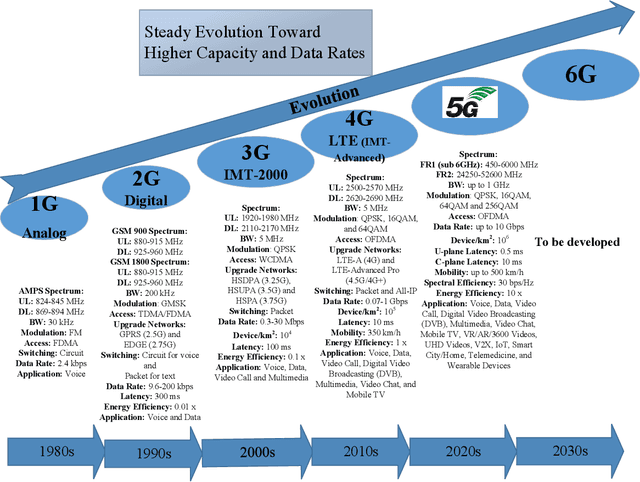
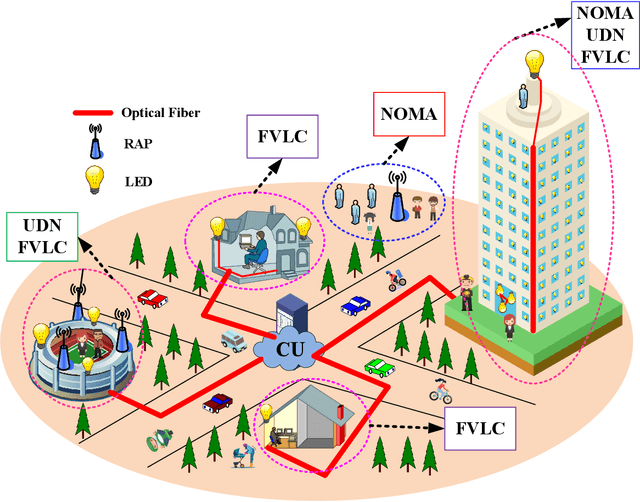
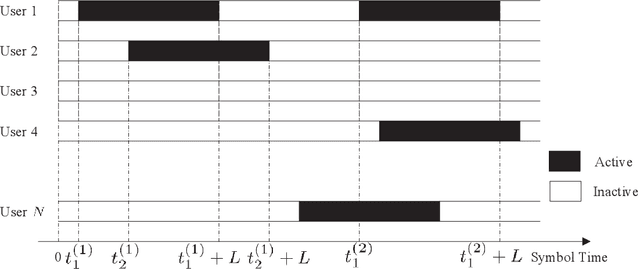
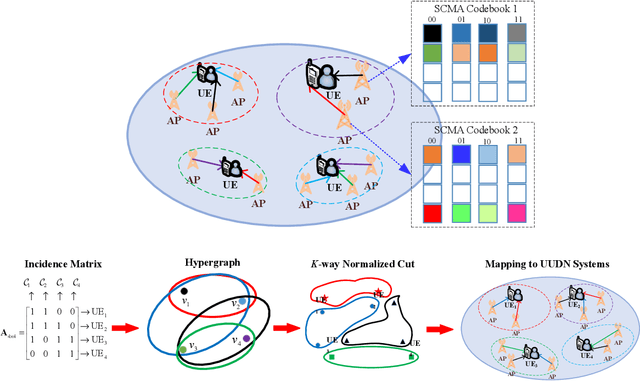
Abstract:As 5G networks rolling out in many different countries nowadays, the time has come to investigate how to upgrade and expand them towards 6G, where the latter is expected to realize the interconnection of everything as well as the development of a ubiquitous intelligent mobile world for intelligent life. To enable this epic leap in communications, this article provides an overview and outlook on the application of sparse code multiple access (SCMA) for 6G wireless communication systems, which is an emerging disruptive non-orthogonal multiple access (NOMA) scheme for the enabling of massive connectivity. We propose to apply SCMA to a massively distributed access system (MDAS), whose architecture is based on fiber-based visible light communication (FVLC), ultra-dense network (UDN), and NOMA. Under this framework, we consider the interactions between optical front-hauls and wireless access links. In order to stimulate more upcoming research in this area, we outline a number of promising directions associated with SCMA for faster, more reliable, and more efficient multiple access in future 6G communication networks.
 Add to Chrome
Add to Chrome Add to Firefox
Add to Firefox Add to Edge
Add to Edge